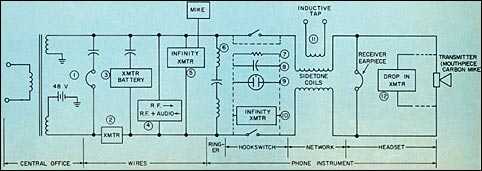12 Ways To Tap A Telephone
by John F. Mason, Associate Editor
Electronic Design, September 27, 1973

To record a conversation a tape recorder is activated by the normal voltage drop that takes place when a telephone receiver is lifted off its hook. The drop from 48 V to between 6 and 9 V (1) activates a relay which turns the tape recorder on. The recorder is connected to the telephone either inductively or directly.
An important component to this tap, not shown in the diagram, is supplied in equipment built in Windsor, Canada, by the Research Electronics Co. A filter is included to clear up any extraneous noise on the line. Noise comes from a frayed line, from lightning or a bad transformer - factors that have nothing to do with a phone's being tapped. But if the buggees get suspicious - even for the wrong reasons - the whole operation could fail. To avoid this, clearing filters are used.
Another tap, shown in the diagram (2) is a series-connected transmitting bug, which draws its power from the telephone line. It transmits both sides of a conversation when the phone is off the hook. The advantage of this kind of tap is that once the bug has been installed physical access to the telephone line is not necessary again. The bug is placed anywhere along the line from the handset to the central office.
A parallel-connected transmitter (3) may be used in conjunction with a battery. Since this device is isolated from the telephone lines by a capacitor it doesn't disturb the electrical parameters of the line. A disadvantage, however, is that it must transmit continuously, which, of course, shortens the battery life. It, too, can be connected anywhere along the line.
Another technique used to bug telephones is rf flooding (4). What it amounts to is flooding the telephone with high level rf signals and retrieving the signals which have been modulated by the carbon microphone.
Tuning in on the room
The famous infinity transmitter, also known as the harmonica bug, can be inserted into the telephone at either of two points, (5) or (10). When the bugger wishes to listen to your room conversation he dials your number, then blows on a harmonica or pitch pipe before your phone rings. The high tone prevents the ring as well as activates the room microphone.
Refinements have outmoded the harmonica in some cases. Now circuits are activated by a signal from a small electronic tone generator.
The ringer coils in some telephones (6) are used to pick up audio in a room. These coils transmit voice signals over the lines to a high-gain, low-noise audio amplifier.
There are a number of ways to rewire the telephone by using a good amplifier somewhere between the central office and the telephone that will enable a listener to pick up a room conversation while the phone is on the hook. He can short one side of the hookswitch and:
* Put a resistor (7) across the other hookswitch so that a small amount of current will trickle through the carbon microphone.
* Use a capacitor (8) across the second hookswitch and rewire the receiver. Now the room audio will be available on the line.
* Place a neon bulb (9) across the second hookswitch. A high voltage pulse of about 100 V will now defeat the hookswitch.
* Use an infinity transmitter as either the receiving or transmitting element in the handset as the microphone. Or a small separate microphone may be hidden inside the phone instrument.
An inductive tap (11), probably the most commonly used technique, involves placing a flat coil or suction-cup mounted coil next to the network. Since the network has coils inside it, a magnetic field containing the conversation may be sampled by inductive coupling.
A cheap, quick and effective way to tap a phone is the drop-in transmitter (12). The mouthpiece is unscrewed, the original carbon mike removed and the transmitter dropped in.
|


